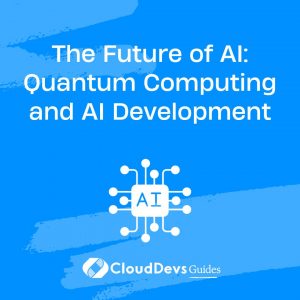The Future of AI: Quantum Computing and AI Development
In the ever-evolving landscape of technology, the synergy between artificial intelligence (AI) and quantum computing has emerged as one of the most promising frontiers. This convergence holds the potential to revolutionize industries, scientific research, and problem-solving capabilities. In this blog, we’ll delve into the fascinating realm of quantum computing and AI development, exploring the synergies, challenges, and breakthroughs that are shaping the future of both fields.
1. Understanding Quantum Computing
1.1. Unleashing the Power of Qubits
At the heart of quantum computing lies the qubit, the fundamental unit of quantum information. Unlike classical bits that can only exist in states of 0 or 1, qubits can exist in a superposition of states. This unique property allows quantum computers to perform complex calculations at an unprecedented speed by evaluating multiple possibilities simultaneously.
python
from qiskit import QuantumCircuit, Aer, transpile
from qiskit.visualization import plot_bloch_multivector
# Create a quantum circuit with a single qubit
qc = QuantumCircuit(1)
# Apply a Hadamard gate to create a superposition
qc.h(0)
# Visualize the qubit's state using Bloch sphere
backend = Aer.get_backend('statevector_simulator')
job = backend.run(transpile(qc, backend))
result = job.result().get_statevector()
plot_bloch_multivector(result)
1.2. Entanglement: Quantum Interconnectedness
Entanglement, another foundational quantum phenomenon, plays a pivotal role in quantum computing. Entanglement allows qubits to become interconnected in such a way that the state of one qubit instantaneously influences the state of another, regardless of the distance between them. This property offers incredible potential for developing advanced AI algorithms with enhanced parallelism and correlation handling.
2. Synergies between Quantum Computing and AI
2.1. Accelerating Machine Learning with Quantum Speed
One of the most exciting prospects of integrating quantum computing with AI lies in accelerating machine learning algorithms. Quantum computers can process large datasets and complex mathematical operations exponentially faster than classical computers. This advantage can drastically speed up tasks like optimization, clustering, and pattern recognition.
python
import numpy as np
from qiskit.aqua.algorithms import VQC
from qiskit.aqua.components.optimizers import COBYLA
# Generate a sample dataset
np.random.seed(0)
num_samples = 100
num_features = 5
X = np.random.rand(num_samples, num_features)
y = np.random.randint(2, size=num_samples)
# Create a Quantum Variational Classifier
quantum_instance = QuantumInstance(backend=Aer.get_backend('statevector_simulator'))
vqc = VQC(optimizer=COBYLA(maxiter=100), quantum_instance=quantum_instance)
# Train the classifier on the dataset
vqc.fit(X, y)
2.2. Solving Complex Problems through Quantum AI
Quantum AI combines the strengths of both fields to tackle some of the most complex and computationally intensive problems. For instance, optimization problems encountered in supply chain management, financial modeling, and drug discovery can be solved more efficiently using quantum-inspired algorithms. These algorithms exploit the quantum principles of superposition and entanglement to explore multiple solutions simultaneously, converging towards optimal outcomes.
3. Challenges on the Horizon
3.1. Quantum Decoherence and Error Correction
Quantum systems are incredibly sensitive to external influences, a phenomenon known as decoherence. As quantum computers become more complex, maintaining qubits in a coherent state becomes increasingly challenging. Error correction techniques are vital to counteract the effects of decoherence and ensure the accuracy of computations. Developing robust error correction mechanisms is a critical hurdle that must be overcome before quantum computing can fully realize its potential in AI development.
3.2. Limited Qubit Availability and Scalability
Presently, quantum computers with a high number of qubits are a rarity due to technical limitations. Building and maintaining stable qubits is a resource-intensive process. As AI algorithms become more intricate and demand more computational resources, quantum computers must be scaled up significantly to accommodate these requirements. Achieving this scalability while maintaining qubit quality is a formidable task that researchers are actively addressing.
4. The Road Ahead: Quantum Supremacy for AI
The evolution of quantum computing and its integration with AI is poised to reshape industries, research, and innovation. Quantum supremacy, the point at which quantum computers outperform classical computers in specific tasks, is a milestone that could unlock transformative capabilities for AI development.
Quantum AI could lead to breakthroughs in fields such as:
- Drug Discovery: Accelerating the discovery of new drugs by simulating molecular interactions at a quantum level.
- Financial Modeling: Enabling more accurate risk assessment and portfolio optimization.
- Climate Modeling: Enhancing simulations to predict and mitigate the impacts of climate change.
- Cryptography: Revolutionizing secure communication through quantum-resistant encryption methods.
Conclusion
The future of AI development is intimately intertwined with the evolution of quantum computing. As these two fields converge, we stand at the cusp of a technological revolution with the potential to solve problems that were once deemed insurmountable. While challenges remain, the rapid advancements and collaborations within both disciplines offer a promising outlook. Quantum computing’s ability to process information in ways previously thought impossible, coupled with AI’s capacity to analyze and learn from complex data, heralds a new era of innovation that will undoubtedly shape the world for generations to come.
In closing, the journey ahead is not without obstacles, but the fusion of quantum computing and AI holds the promise of creating a future that is smarter, more connected, and more capable than ever before.
Table of Contents









